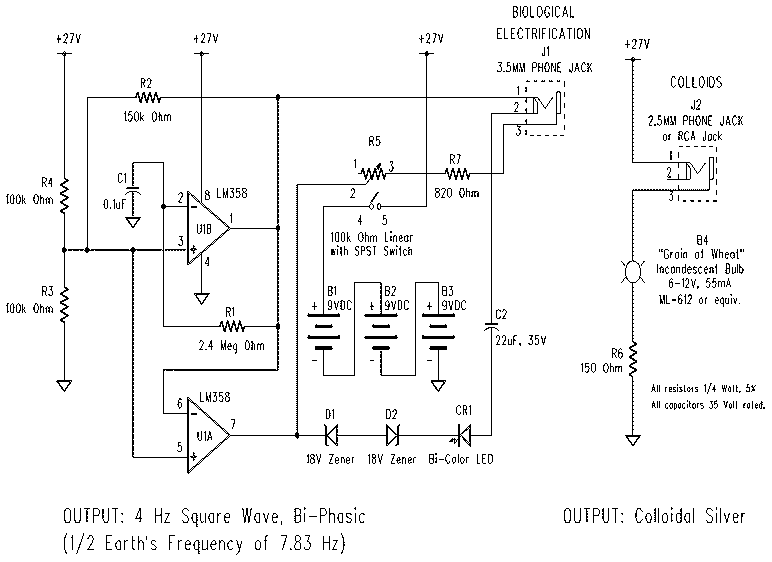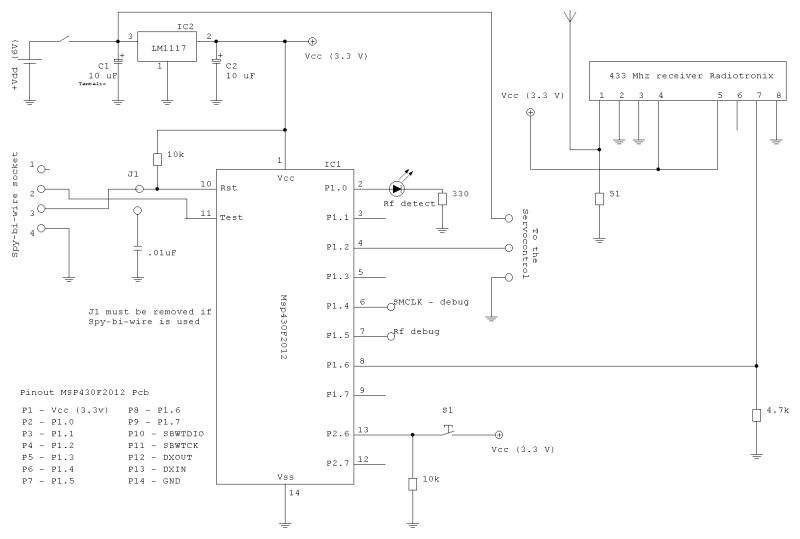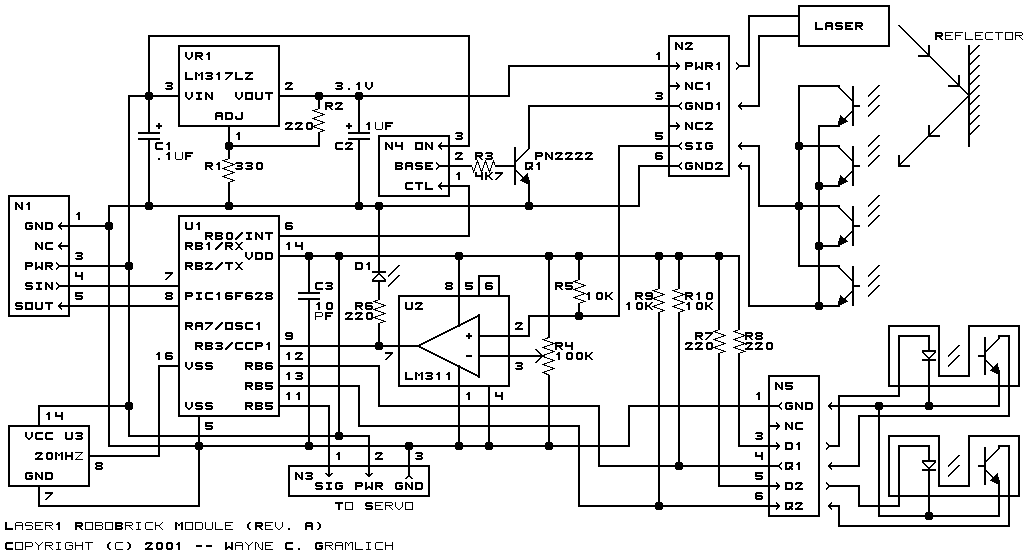
Bob Beck Electrifier

The procedure requires no doctors, drugs, or medical bills. It involves sterilizing the blood of viruses, bacteria, parasites, fungi, microbes, pathogens, mycotoxins, and foreign life forms by passing a small current through the body. The original procedure, invented and patented (US patent # 5139684) by Dr. S. Kaali, MD, involved removing blood from the body, electrifying it, and returning it. Dr. Bob Beck simplified this concept for home use, believing that blood should remain in the body and be electrified by attaching electrodes externally. Instead of using direct current, he reversed polarity at a rate of 4Hz to prevent electrolysis. Although Dr. Beck did not patent the process, he made it public domain, providing schematics for individuals to construct inexpensive units for personal use. The procedure has been reported to reduce the ability of HIV-1 to infect healthy cells. Testimonials from users of the Beck device suggest that this procedure is effective. However, while the blood electrifier targets the blood system, foreign invaders can reside in tissues. A magnetic pulser can induce electrical current in tissues, effectively killing pathogens by applying the same principle of blood electrification through collapsing magnetic fields. Colloidal silver, when taken in normal doses, has no known side effects and is beneficial against various diseases without creating drug-resistant strains. This document describes a Plant Growth Stimulator that has been improved since its 1991 design. It has been user-tested for over two years and is solid-state (no relays), using three batteries instead of seven. It produces colloids, is smaller, lighter, silent, and features battery-saving capabilities. It is available as a mostly-assembled kit with electrodes and silver for approximately $100 from Action Electronics, located at 1300 E. Edinger Ave., Santa Ana, CA 92705 (714) 547-5169. The first section (U1A) of the LM358 dual op-amp functions as a 50-volt peak-to-peak square wave oscillator. The second section (U1B) reverses polarity and provides a +27 VDC low impedance output. This setup delivers a biphasic output with a sharp rise time of approximately 4 Hz (not critical) for the biological cotton-covered stainless-steel electrodes, which should be saturated with salt water before use. The sharp rise time is essential for generating higher odd harmonics in the stimulus, although rounded waveforms will produce a different sensation. The third section provides a current-limited 27 VDC output from a separate RCA jack for the rapid generation of colloidal silver in water. A 3-minute cycle in 8 ounces of room-temperature water yields a concentration of approximately 3 ppm. The 4 Hz oscillator frequency in op-amp section U1A is determined by capacitor C1 (0.1 mF) and resistor R1 (2.4 megΩ). It is configured as a comparator with hysteresis set by resistor R2 (150 kΩ). The charging and discharging of C1 is managed by the 180-degree out-of-phase signal through R1. Resistors R3 and R4 provide a set-point of half the V+ to the comparator, ensuring a 50% duty cycle square wave with an amplitude slightly below the ~27V supply. U1B, the second comparator, inverts the output of oscillator U1A, generating a ~50V peak-to-peak signal between the op-amps due to their 180-degree phase difference. The current of U1B is limited by potentiometer R5 (100 kΩ) and resistor R7 (820 Ω), allowing individual users to adjust the output to their comfort level. The power indicator circuit includes a bicolor (red-green) LED (CR1) and a series combination of two 18V Zener diodes (D1 & D2), with power limited by capacitor C2 (22 mF). This section of the device is automatically disabled.
The overall design of the device emphasizes user safety and functionality. The use of a dual op-amp configuration allows for efficient signal processing, while the inclusion of current-limiting components ensures that the output remains within safe limits for user comfort. The integration of a colloidal silver generation feature further enhances the utility of the device, providing an additional therapeutic option. The specifications of the components used, including the operational amplifiers and passive elements, are chosen to optimize performance while maintaining compactness and ease of use. The device is aimed at individuals seeking alternative health solutions, combining principles of electrotherapy and colloidal silver generation in a single, user-friendly unit.It requires no doctors, drugs, or medical bills. The procedure involves sterilizing the blood of viruses, bacteria, parasites, fungus, microbes, pathogens, mycotoxins and coexisting foreign life forms and alien invaders and their byproducts by passing a small current through the body. The original procedure invented and patented (US patent # 5139684) by Dr. S. Kaali, MD, involved removing the bloodfrom the body, electrifying it, and returning it to the body. The concept was simplified and made suitable for home use by Dr. Bob Beck, who thought that the blood should be left in the body where it belonged, and electrified by attaching electrodes to the body. And rather than use direct current, to prevent electrolysis he reversed polarity at a 4Hz rate. Dr. Beck did not patent the process, but placed it into the public domain and published schematics and information to allow anyone to build and use an inexpensive unit for him/herself.
for discrete exposure time intervals can attenuate the ability of HIV-1 to infect normally healthy cells . ( Patent #5139684, p. 19). In other words, electricity can boot the AIDS virus from the body. But there are testimonials from users of the Beck device, that this procedure is effective The blood electrifier only has effect on the blood system, but alien invaders can hide in the tissues.
A magnetic pulser works by inducing electrical current in the tissues, so it kills pathogens by the same principle of blood electrification, but indirectly by use of collapsing magnetic fields. Colloidal silver in normal doses has no known side effects, and has been found to be beneficial against many diseases.
Plus, it will not create drug resistant strains. This 11/24/`96 page describes a Plant Growth Stimulator improved since my 1991 design. User-tested for over two years, it is solid state (no relays), uses three (not seven) batteries, makes colloids, is much smaller, lighter, silent with battery saving features and is available as a mostly-assembled kit complete with electrodes and silver for about $100 from Action Electronics, 1300 E. Edinger Ave. , Santa Ave. , Santa Ana, CA 92705 (714)547-5169. The first section (U1A) of the LM358 dual op-amp is a 50 volt peak-to-peak square wave oscillator. The second section (U1B) reverses polarity and provides + 27 VDC output of low impedance. This delivers a biphasic, sharp rise-time output of ~ 4 Hz (not critical) for the biological cotton-covered stainless-steel electrodes saturated with salt water before applying.
Sharp rise-time is considered necessary to provide higher odd harmonics to the stimulus, although rounded waveforms will feel different. The third section is a current-limited 27VDC output from a separate RCA jack for rapid generation of excellent colloidal silver in water.
A 3 minute cycle in 8 Oz. of room-temperature water makes a ~3 ppm concentration. Op-amp section 1A`s 4 Hz oscillator frequency is set by C1 (0. 1 mF) and R1 (2. 4 megW). It is configured as a comparator with hysteresis determined by R2 (150 kW). Charging and discharging of C1 is done by the 180 degree out-of-phase signal through R1. R3 and R4 provide a set-point 1/2 the V+ to the comparator. This ensures a 50% duty cycle square wave with an amplitude of slightly less than the ~27V supply. U1B, the second comparator, is used to invert the output of oscillator U1A. A ~50V peak-to-peak signal will be generated between the op-amps due to their output being 180 degrees out of phase. U1B`s current is limited by potentiometer R5 (100 kW) and R7 (820 W) and is set to individual user`s comfort.
The power indicator circuit consists of a bicolor (red-green) LED (CR1) and the series combination of two 18V Zener diodes, D1 & D2 with power limited by C2 (22 mF). This section of the device is automatically disa 🔗 External reference
The overall design of the device emphasizes user safety and functionality. The use of a dual op-amp configuration allows for efficient signal processing, while the inclusion of current-limiting components ensures that the output remains within safe limits for user comfort. The integration of a colloidal silver generation feature further enhances the utility of the device, providing an additional therapeutic option. The specifications of the components used, including the operational amplifiers and passive elements, are chosen to optimize performance while maintaining compactness and ease of use. The device is aimed at individuals seeking alternative health solutions, combining principles of electrotherapy and colloidal silver generation in a single, user-friendly unit.It requires no doctors, drugs, or medical bills. The procedure involves sterilizing the blood of viruses, bacteria, parasites, fungus, microbes, pathogens, mycotoxins and coexisting foreign life forms and alien invaders and their byproducts by passing a small current through the body. The original procedure invented and patented (US patent # 5139684) by Dr. S. Kaali, MD, involved removing the bloodfrom the body, electrifying it, and returning it to the body. The concept was simplified and made suitable for home use by Dr. Bob Beck, who thought that the blood should be left in the body where it belonged, and electrified by attaching electrodes to the body. And rather than use direct current, to prevent electrolysis he reversed polarity at a 4Hz rate. Dr. Beck did not patent the process, but placed it into the public domain and published schematics and information to allow anyone to build and use an inexpensive unit for him/herself.
for discrete exposure time intervals can attenuate the ability of HIV-1 to infect normally healthy cells . ( Patent #5139684, p. 19). In other words, electricity can boot the AIDS virus from the body. But there are testimonials from users of the Beck device, that this procedure is effective The blood electrifier only has effect on the blood system, but alien invaders can hide in the tissues.
A magnetic pulser works by inducing electrical current in the tissues, so it kills pathogens by the same principle of blood electrification, but indirectly by use of collapsing magnetic fields. Colloidal silver in normal doses has no known side effects, and has been found to be beneficial against many diseases.
Plus, it will not create drug resistant strains. This 11/24/`96 page describes a Plant Growth Stimulator improved since my 1991 design. User-tested for over two years, it is solid state (no relays), uses three (not seven) batteries, makes colloids, is much smaller, lighter, silent with battery saving features and is available as a mostly-assembled kit complete with electrodes and silver for about $100 from Action Electronics, 1300 E. Edinger Ave. , Santa Ave. , Santa Ana, CA 92705 (714)547-5169. The first section (U1A) of the LM358 dual op-amp is a 50 volt peak-to-peak square wave oscillator. The second section (U1B) reverses polarity and provides + 27 VDC output of low impedance. This delivers a biphasic, sharp rise-time output of ~ 4 Hz (not critical) for the biological cotton-covered stainless-steel electrodes saturated with salt water before applying.
Sharp rise-time is considered necessary to provide higher odd harmonics to the stimulus, although rounded waveforms will feel different. The third section is a current-limited 27VDC output from a separate RCA jack for rapid generation of excellent colloidal silver in water.
A 3 minute cycle in 8 Oz. of room-temperature water makes a ~3 ppm concentration. Op-amp section 1A`s 4 Hz oscillator frequency is set by C1 (0. 1 mF) and R1 (2. 4 megW). It is configured as a comparator with hysteresis determined by R2 (150 kW). Charging and discharging of C1 is done by the 180 degree out-of-phase signal through R1. R3 and R4 provide a set-point 1/2 the V+ to the comparator. This ensures a 50% duty cycle square wave with an amplitude of slightly less than the ~27V supply. U1B, the second comparator, is used to invert the output of oscillator U1A. A ~50V peak-to-peak signal will be generated between the op-amps due to their output being 180 degrees out of phase. U1B`s current is limited by potentiometer R5 (100 kW) and R7 (820 W) and is set to individual user`s comfort.
The power indicator circuit consists of a bicolor (red-green) LED (CR1) and the series combination of two 18V Zener diodes, D1 & D2 with power limited by C2 (22 mF). This section of the device is automatically disa 🔗 External reference

